Response functions
2019-05-13
responsefunctions.Rmd


Introduction
Response functions can provide a more complete picture than single value methods that were presented in the Static BE vignette. Static BE methods tend to be very simple to apply but their interpretation and any derivative values determined from them should be treated as rough estimates in all but the most ideal circumstances. In the Synthetic example vignette we fit barometric response functions for a synthetic dataset with a known response function to test the efficiency of different methods.
This vignette shows how to calculate the impulse response functions (time domain) and frequency response functions (frequency domain) for water levels, barometric pressure and Earth tides using field data. Including terms for Earth tides is suggested for confined and semi-confined aquifers so our examples will show how to easily include them with the earthtide package.
Time domain barometric response function
We have decided to take the approach used in the recipes package for the time being where we provide steps to build our dataset to be used for linear regression. By building the dataset with a recipe, it also allows for the user to easily specify the model of choice. For our examples we will use the lm function to determine the appropriate parameters. By the end of the time-domain section we will have fit the data using the following methods:
- Lagged barometric response
- Regular spaced (Rasmussen and Crawford 1997)
- Irregular spacing
- Distributed lag
- Earth tides
- Harmonic (specified frequencies) (Rasmussen and Mote 2007)
- Theoretical
- Lagged (Toll and Rasmussen 2007)
- Harmonic constituents (Wenzel 1996)
- Background trend (spline fit)
- Level shifts
Regular and irregular spaced lag method
Regular and irregular lag models can be specified in the same manner. In this example we generate a set of regularly spaced lags using seq, but they could be specified individually or with another function. We find logarithmically spaced lags generated with log_lags can work well to get good resolution at early times while still having a parsimoneous model.
Monitoring interval: 2 minutes
Barometric lag range: 0 to 360 by 5
Earth tide lag range: 0 to 180 by 15
Natural spline fit for temporal trend with 31 degrees of freedom
delta_t <- 120 # seconds
max_lag_baro <- 43200/delta_t # 0.5 days
lag_baro_spacing <- 2 # 4 minute between lags
max_lag_et <- 21600/delta_t # 0.25 days
lag_et_spacing <- 15 # 30 minutes between lags
ns_df <- 21 # natural spline with 21 terms
ba_lags <- seq(0, max_lag_baro, lag_baro_spacing) # barometric lag terms (reg)
et_lags <- seq(0, max_lag_et, lag_et_spacing) # earthtide lag terms (reg)Example recipe:
dat <- recipe(wl~., transducer) %>% #1
step_lag_matrix(baro, lag = ba_lags, role = 'lag_matrix_baro') %>% #2
step_lag_matrix(et, lag = et_lags, role = 'lag_matrix_et') %>% #3
step_mutate(datetime2 = as.numeric(datetime)) %>% #4
step_ns(datetime2, deg_free = ns_df, role = 'splines') %>% #5
prep() %>% #6
portion() #7- Take the transducer dataset, use wl as my dependent variable
- Lag the baro column to have a maximum lag of 0.5 day with 4 minute spacing
- Lag the et column to have a maximum lag of 0.25 days with 30 minute spacing
- Convert the datetime column from POSIXt to numeric (necessary for step_ns)
- Generate spline basis function regressors
- Run the steps
- Generate output for lm
Fit the model:
We can fit the model with lm and the fitting method is the same for each of the recipes so we will not repeat that code in the following examples.
fit <- lm(outcome~lag_matrix_baro + lag_matrix_et + splines, dat, # fit model
x = FALSE, y = FALSE, tol = 1e-50,
na.action = na.exclude)
dat <- transducer %>% mutate(residuals = residuals(fit)) # add residuals
resp <- response_from_fit(fit) # get the baro responsesummarize_lm(fit)[, -c('adj_r_squared'), with = FALSE]
#> n_obs n_coef df sigma r_squared AIC BIC logLik
#> 1: 36361 216 36145 0.0003069872 0.9999527 -484821.4 -482976.6 242627.7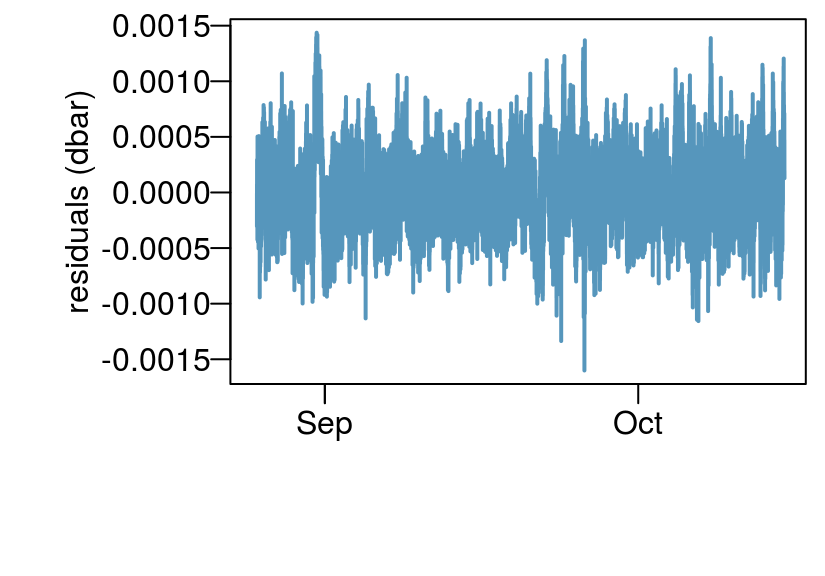
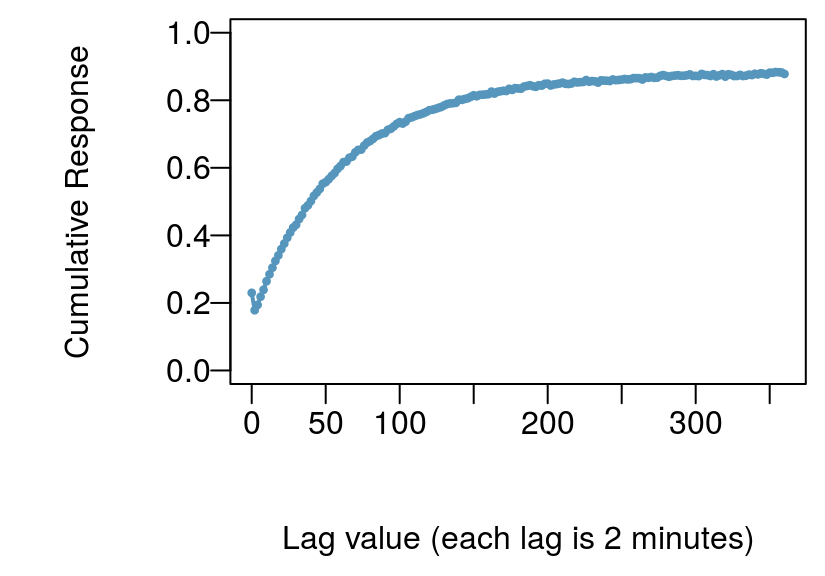
Distributed lag method
For this example we use step_lag_distributed instead of step_lag_matrix. We then specify knots that are logaritmically spaced using log_lags. This decreases the number of regressors while still capturing early time behaviour. Results are visibly similar, however, the distributed lag model is requires fewer regressors, is faster to solve, and provides better early time resolution in this example.
knots <- log_lags(15, max_lag_baro)
dat <- recipe(wl~., transducer) %>%
step_distributed_lag(baro, knots = knots) %>%
step_lag_matrix(et, lag = et_lags) %>%
step_mutate(datetime_num = as.numeric(datetime)) %>%
step_ns(datetime_num, deg_free = ns_df, role = 'splines') %>%
prep() %>%
portion() #> n_obs n_coef df sigma r_squared AIC BIC logLik
#> 1: 36362 49 36313 0.0003061451 0.9999527 -485200.9 -484775.8 242650.4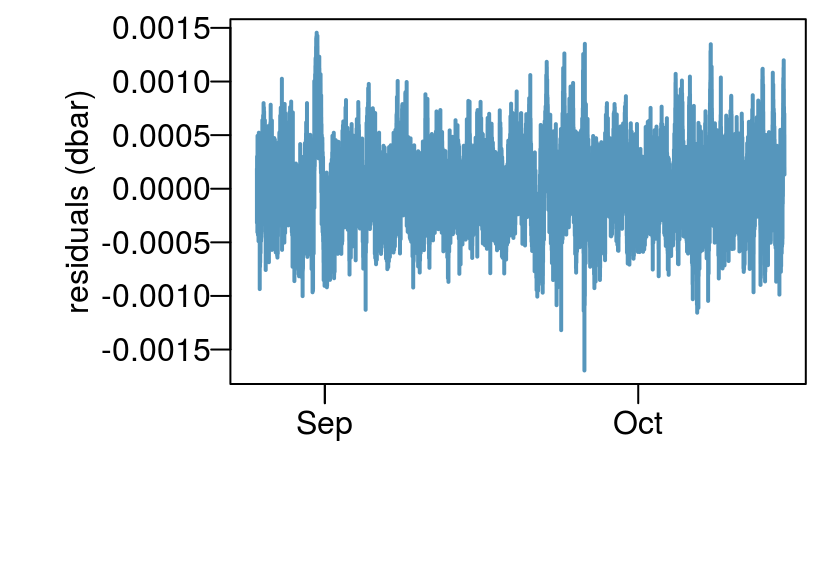
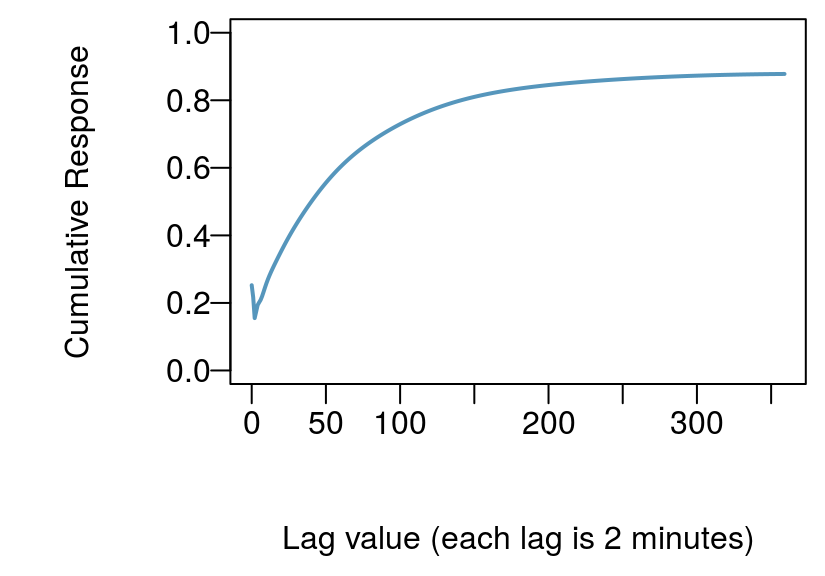
Earth tides
In the previous two examples we used a lagged version of the pre-computed Earth tide signal. We also have the option of directly specifing the Earth tide calcuation in the recipe.
Three primary ways to do this as implemented in waterlevel are:
Using a lagged form of the Earth tide signal. This method uses the earthtide package to calculate a synthetic tide and lag the result. For datasets of less than 14 days, this is the preferred method. The problem is that the regression coefficients are not easily interpreted, but for removing a signal they work well.
Calculate the Earth tide components for wave groups and use those in the regression equation. This method uses the earthtide package to calculate synthetic tidal constituents.
Generate cosine curves of different frequencies. For this method the frequencies are specified in cycles per day and the appropriate sin and cos curves used in regression are created.
Here are example steps for the above three methods:
# Method 1
step_lag_earthtide(datetime,
lag = et_lags,
longitude = -118.67,
latitude = 34.23,
elevation = 550,
wave_groups = wave_groups,
astro_update = 60)
# Method 2
step_earthtide(datetime,
longitude = -118.67,
latitude = 34.23,
elevation = 550,
wave_groups = wave_groups,
astro_update = 60)
# Method 3 with top 6 diurnal and semi-diurnal signals O1, K1, P1, N2, M2, S2
step_harmonic(datetime,
freq = c(0.9295357, 0.9972621, 1.0027379,
1.8959820, 1.9322736, 2.0000000)) Let’s use our previous recipe for the distributed lag dataset but instead use method 2 for Earth tides.
# Select wavegroups
wave_groups <- as.data.table(earthtide::eterna_wavegroups)
wave_groups <- wave_groups[start > 0.5]
wave_groups <- na.omit(wave_groups[time == '1 month', c('start', 'end')])
knots <- log_lags(15, max_lag_baro)
dat <- recipe(wl~., transducer) %>%
step_distributed_lag(baro, knots = knots) %>%
step_earthtide(datetime,
longitude = -118.67,
latitude = 34.23,
elevation = 550,
wave_groups = wave_groups,
astro_update = 60) %>%
step_mutate(datetime_num = as.numeric(datetime)) %>%
step_ns(datetime_num, deg_free = ns_df, role = 'splines') %>%
prep() %>%
portion() #> n_obs n_coef df sigma r_squared AIC BIC logLik
#> 1: 36362 60 36302 0.0003014908 0.9999542 -486304 -485785.4 243213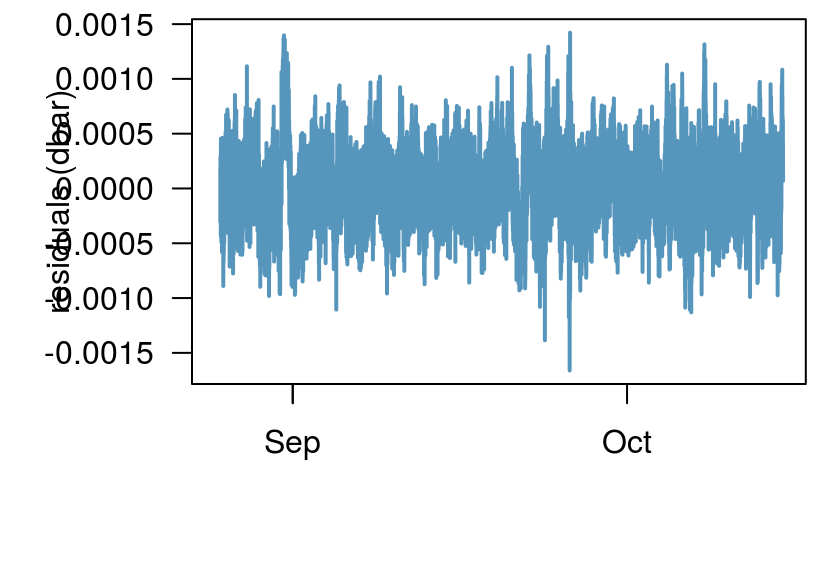
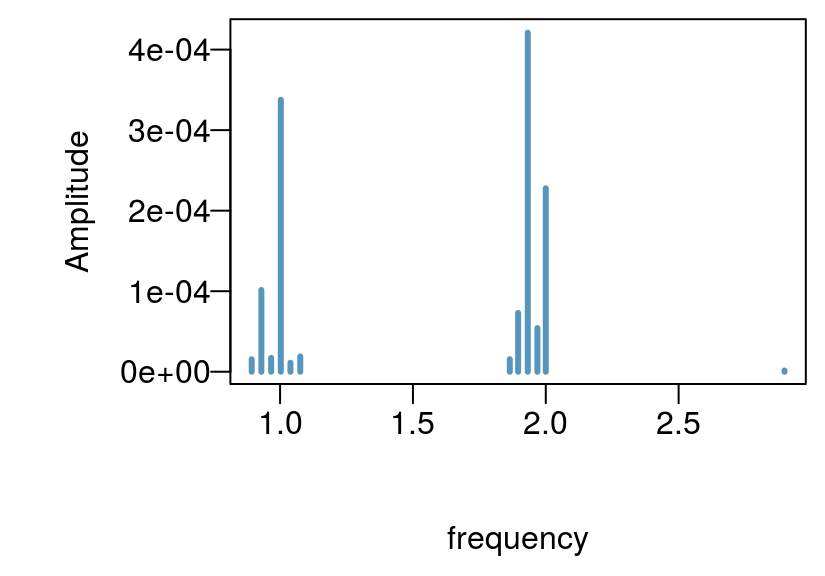
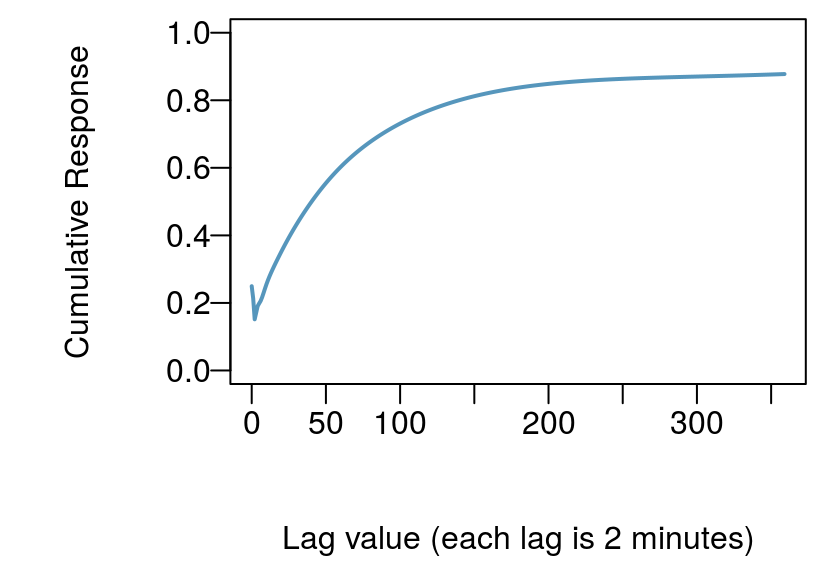
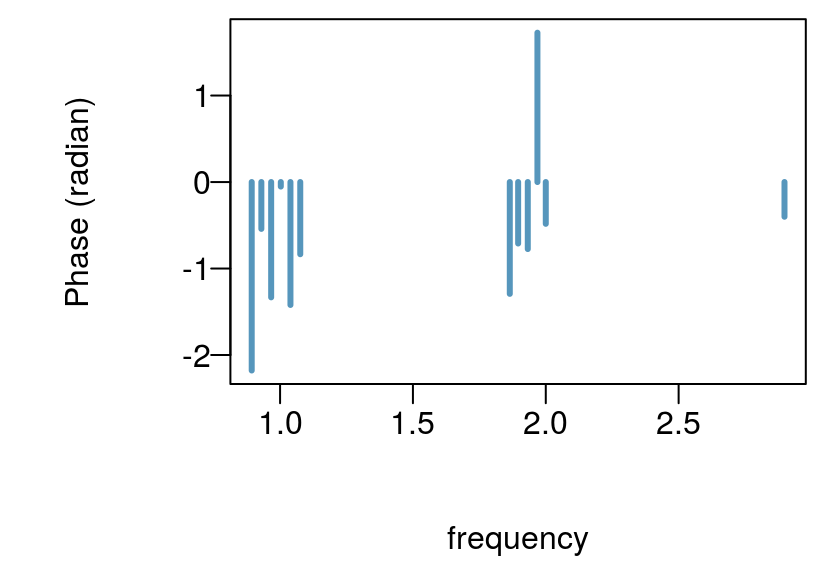
The three models tend to perform similarly for this well. However, I would choose the last model as it has the fewest, regressors, the lowest residual standard error, and provides useful Earth tide amplitude and phase information. This well had a generally small Earth tide component and it is hardly visible in the original wl pressure time series, however, we seem to be able achieve reasonable approximation of the theoretical amplitudes.
Frequency domain response functions
The following papers provide a good introduction to frequency response functions and their applications to water levels (Rojstaczer and Agnew 1989,Lai, Ge, and Wang (2013), Hussein, Odling, and Clark (2013)).
There are currently two ways to calculate the transfer function in the waterlevel package. Using the default method which smooths the periodogram, or using Welch’s method. See spec_pgram and spec_welch for parameters. Often there is a lot of noise at high frequencies. We plot Acworth’s method of static BE as a point in each figure, which is fundamentally just the value of the transfer function at 2 cycles per day (Acworth et al. (2016)). These methods also output the phase and coherence, but for the following plots we will stick to gain which can be thought of as the loading efficiency as a function of frequency for these examples.
tf_pgram <- transfer_fun(transducer,
vars = c('wl', 'baro', 'et'),
time = 'datetime',
method = 'spec_pgram',
spans = c(3))
tf_welch <- transfer_fun(transducer,
vars = c('wl', 'baro', 'et'),
time = 'datetime',
method = 'spec_welch',
n_subsets = 10)
# Acworth BE
be_a <- be_acworth(transducer, wl = 'wl', ba = 'baro', et = 'et',
inverse = FALSE)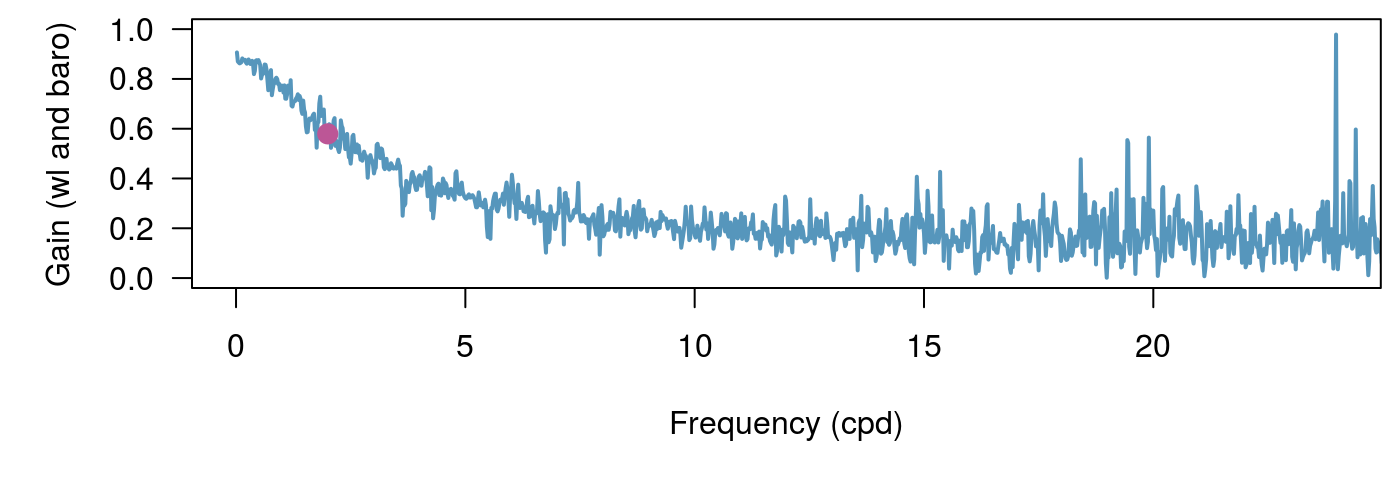
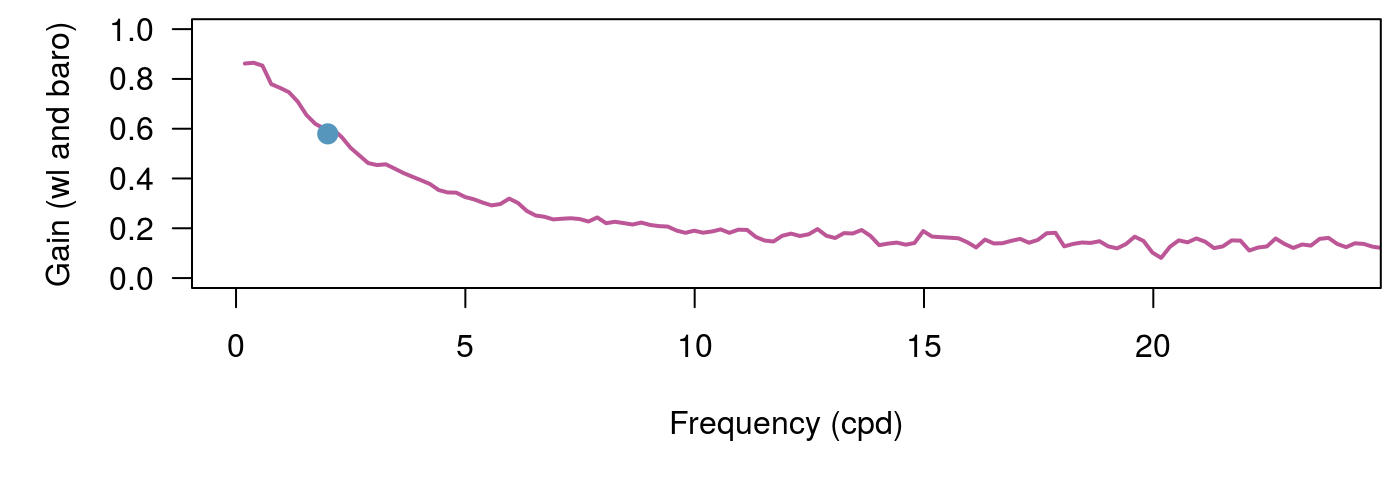
One way to decrease the noise is to use Konno-Ohmachi smoothing (Konno and Ohmachi 1998). This method can be slow for large datasets so we provide serial and parallel versions, konno_ohmachi_parallel, konno_ohmachi_serial.
tf_pgram <-
tf_pgram %>%
mutate(gain_wl_baro_smooth = konno_ohmachi_parallel(tf_pgram$gain_wl_baro,
tf_pgram$frequency,
b = 10))
tf_welch <-
tf_welch %>%
mutate(gain_wl_baro_smooth = konno_ohmachi_parallel(tf_welch$gain_wl_baro,
tf_welch$frequency,
b = 10))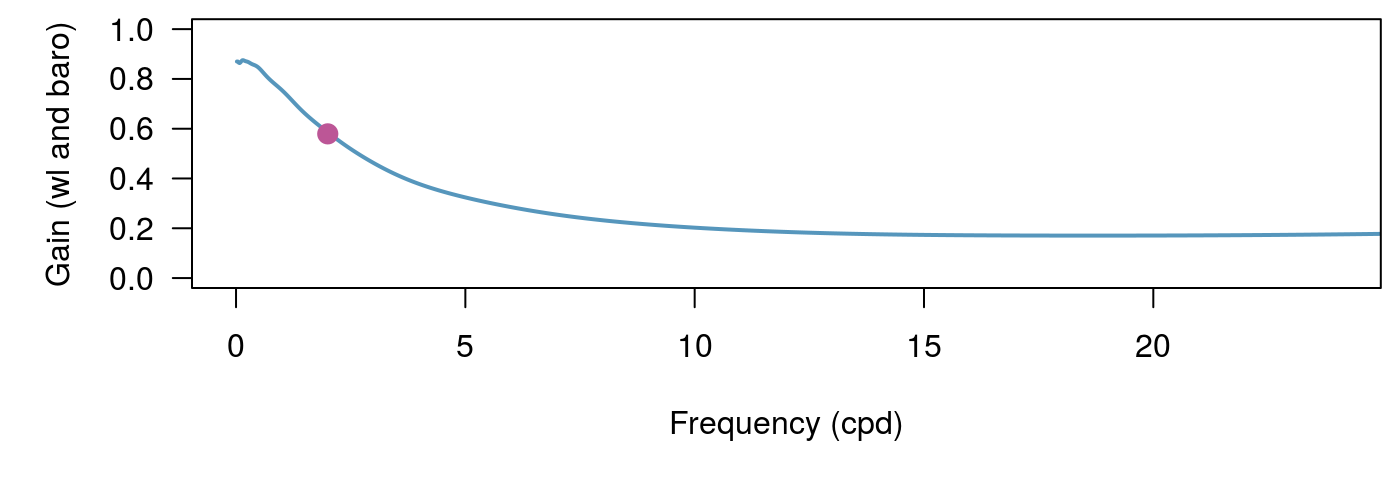
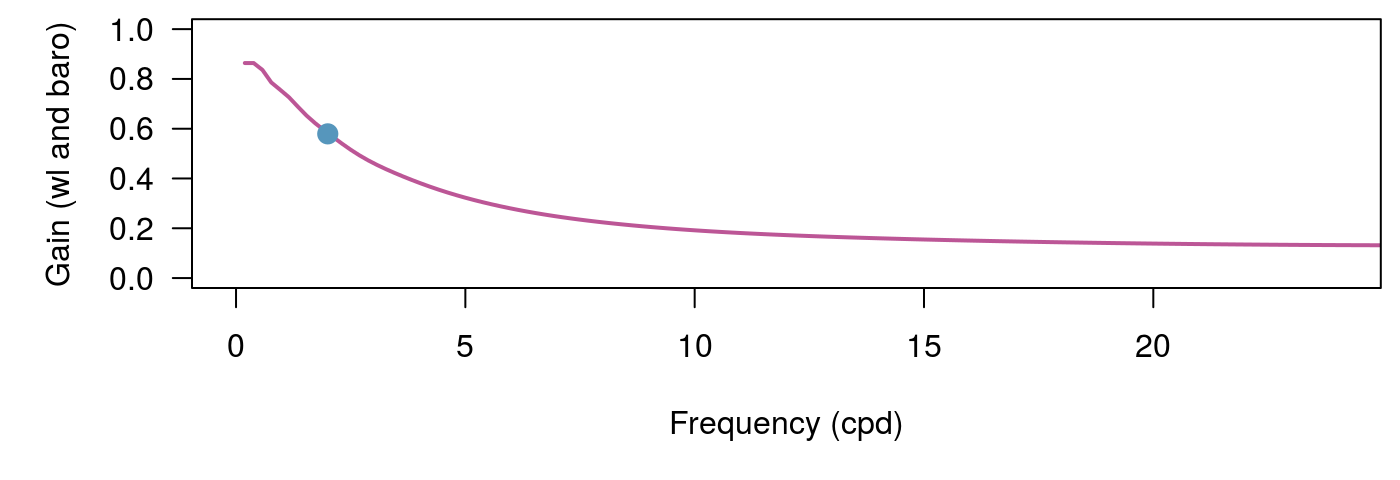
The frequency response methods are robust but often parameters may need to be tuned for a particular study. In particular, when calculating high frequency portions of spectra the Welch’s method with many subsets can perform well.
References
Acworth, R. I., L. J. Halloran, G. C. Rau, M. O. Cuthbert, and T. L. Bernardi. 2016. “An objective frequency domain method for quantifying confined aquifer compressible storage using Earth and atmospheric tides.” Geophysical Research Letters 43 (22). John Wiley & Sons, Ltd: 11, 671–11, 678. doi:10.1002/2016GL071328.
Hussein, Mahmoud EA, Noelle E Odling, and Roger A Clark. 2013. “Borehole Water Level Response to Barometric Pressure as an Indicator of Aquifer Vulnerability.” Water Resources Research 49 (10). Wiley Online Library: 7102–19.
Konno, Katsuaki, and Tatsuo Ohmachi. 1998. “Ground-Motion Characteristics Estimated from Spectral Ratio Between Horizontal and Vertical Components of Microtremor.” Bulletin of the Seismological Society of America 88 (1). The Seismological Society of America: 228–41.
Lai, Guijuan, Hongkui Ge, and Weilai Wang. 2013. “Transfer Functions of the Well-Aquifer Systems Response to Atmospheric Loading and Earth Tide from Low to High-Frequency Band.” Journal of Geophysical Research: Solid Earth 118 (5). Wiley Online Library: 1904–24.
Rasmussen, Todd C, and Leslie A Crawford. 1997. “Identifying and Removing Barometric Pressure Effects in Confined and Unconfined Aquifers.” Groundwater 35 (3). Wiley Online Library: 502–11.
Rasmussen, Todd C, and Thomas L Mote. 2007. “Monitoring Surface and Subsurface Water Storage Using Confined Aquifer Water Levels at the Savannah River Site, Usa.” Vadose Zone Journal 6 (2). Soil Science Society: 327–35.
Rojstaczer, Stuart, and Duncan Carr Agnew. 1989. “The Influence of Formation Material Properties on the Response of Water Levels in Wells to Earth Tides and Atmospheric Loading.” Journal of Geophysical Research: Solid Earth 94 (B9). Wiley Online Library: 12403–11.
Toll, Nathanial J, and Todd C Rasmussen. 2007. “Removal of Barometric Pressure Effects and Earth Tides from Observed Water Levels.” Groundwater 45 (1). Wiley Online Library: 101–5.
Wenzel, Hans-Georg. 1996. “The Nanogal Software: Earth Tide Data Processing Package Eterna 3.30.” Bull. Inf. Marées Terrestres 124: 9425–39.